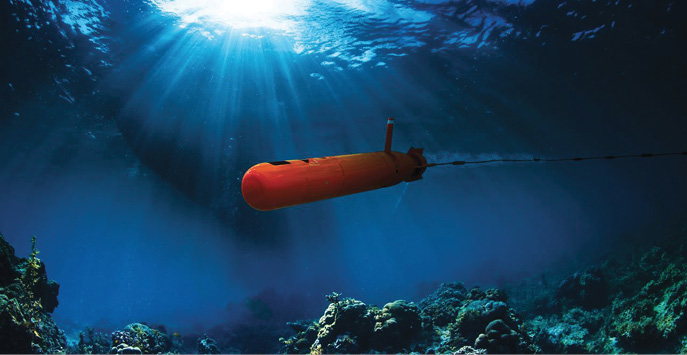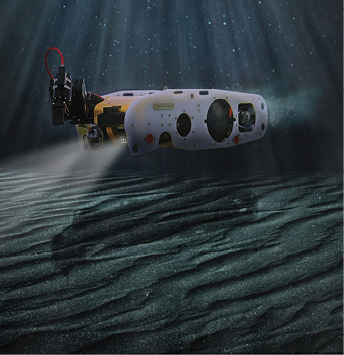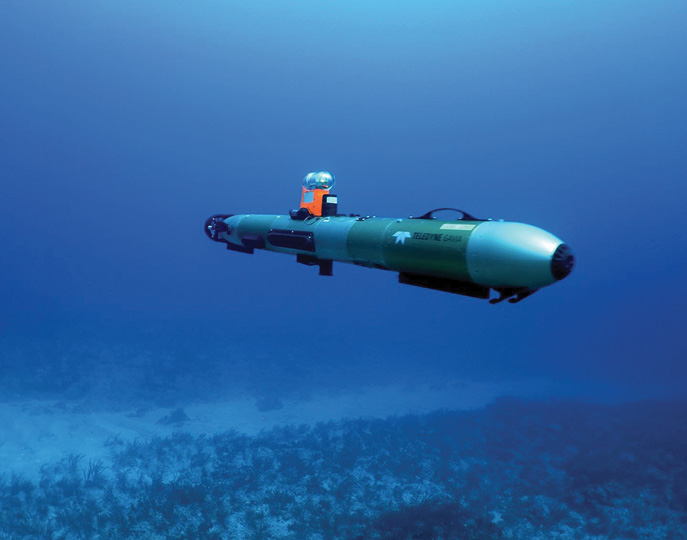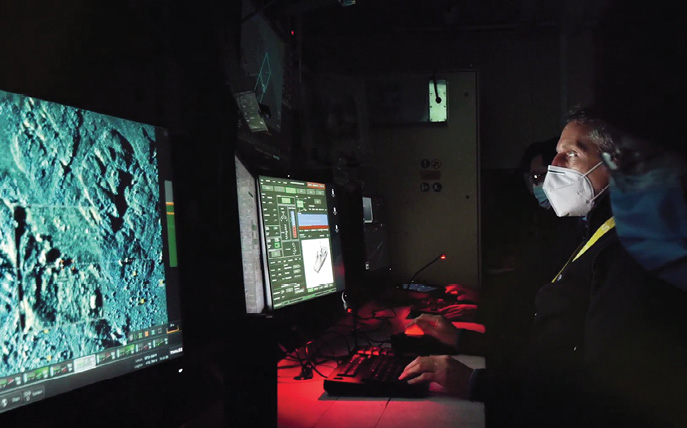Militaries Are Taking Unmanned Underwater
Riptide AUV from BAE Systems
As systems continue to evolve and data collection becomes more sophisticated, autonomous underwater vehicles (AUVs) are playing a bigger military role.
Autonomous underwater vehicles (AUVs) are taking on a variety of missions and gathering critical information for navies around the world. These systems hunt for mines, provide surveillance, map sea floors and record water quality measurements, while carrying payloads that are increasingly more sophisticated.
Also known as unmanned underwater vehicles (UUVs), militaries see the value these systems provide and their potential impact on operations. They’re looking for vehicles that can go deeper underwater for longer durations, and that can supply actionable information in real time—all with minimal human intervention.
Of course, challenges must be overcome before we get there. Communication isn’t easy underwater, and there’s really no way for a human to take control if something goes wrong. And because there’s no GPS, AUVs rely on onboard sensors that aid navigation and provide information about the environment to stay on track. These solutions have to be robust and ideally come in small form factors.
Autonomy is also a must. Militaries need to trust that when they send an AUV out on its mission, it’s actually performing the necessary tasks and can make decisions on its own. That’s why underwater systems must be even smarter than their aerial counterparts—and they’re certainly getting there.
AUV manufacturers and sensor providers are working to expand capabilities with smaller, more sophisticated payloads, improving endurance with lower energy consumption and training AI algorithms to provide that all-important autonomy. As they continue to evolve and earn trust, AUVs are poised to play a larger role in the water domain, expanding current use cases and taking on other tasks that keep sailors out of harm’s way.

APPLICATIONS
From seafloor mapping to subsea and seabed warfare capabilities in intelligence, survey and reconnaissance (ISR), AUVs are becoming important maritime assets. To see also : DVIDS – News – ROTC cadets receive Cyber Defense education at West Point. With advancements in data collection further expanding their potential, militaries are getting even more out of these systems, said Jayne Shelton, Riptide (UUV) product line director for BAE Systems.
Two main types of AUVs are performing these military missions: gliders and propeller-driven, Teledyne Marine Senior Vice President, Defense Strategy and Business Development Thomas W. Altshuler said. Propeller-driven vehicles are the most common, and are typically tasked with measuring surfaces. They come in various sizes, tend to carry sonars, can map the sea floor and help locate missing aircraft. These systems are typically deployed for mine countermeasures (MCM), locating unexploded ordnance that can do harm. There are also hybrid solutions with features of both.
MCM is one of the early adopters providing critical safety for operators, Thales Group Product Line Director for Mine Warfare Systems Matthew Hunt said. AUVs use sonar to quickly identify a threat and in some cases even neutralize it, taking humans out of the process.
“Mine hunting in contested environments is the biggest mission special forces do,” said Daryl Slocum, director of AUV technologies, AUV systems integrated mission systems for L3Harris. “Providing situational awareness is a pretty significant mission set as well. The vehicle goes in for a pre-survey, looking at potential landing areas before putting anyone in harm’s way.”
AUVs are also being used as decoys, Shelton said, giving off signals similar to a submarine in an area where known adversaries linger.
Gliders use a buoyancy engine to propel through the water, Altshuler said, and travel in a sawtooth pattern. With these systems, the goal is to determine what’s between the surface of the ocean and the seafloor. They’re primarily tasked with measuring water column properties so users can better understand their operational environment, including weather. The gliders, which need longer endurance to complete their missions, usually carry conductivity, temperature, depth (CDT) sensors to measure physical oceanographic properties in the water, with the data collected then fed to models.
The Naval Oceanographic Office is a big user of these systems, Altshuler said, providing important information back to the fleet as it travels. They can measure background acoustic properties, for example, which is important for anti-submarine warfare as well as mammal mitigation. The persistent systems also can communicate with other assets, loitering for long periods of time, pulling data from them and then transmitting that data back.


Saab’s AUV62-AT is used to emulate adversary submarines to train airborne, surface and subsurface sonars, weapons and operators in anti-submarine warfare.
SOPHISTICATED PAYLOADS AND TECHNOLOGY
AUV data collection has evolved over the years, Shelton said, with payload advancements the result of research efforts from universities and defense companies. Read also : Tecore Networks Provides Rural Carriers a Path for Rip and Replacement of Existing 2G, 3G, 4G, 5G Network Infrastructure – Galveston County Daily News. BAE, for example, is focused on payload development for ISR, including SIGINT, acoustic sensing and communications, and autonomy that will enable more complex missions.
Side scan sonars were probably the first AUV payloads used, identifying objects based on acoustics, Slocum said. These sensors certainly have evolved over the years, going from only being able to sense big objects like downed aircraft from larger ranges down to centimeters of resolution over similar long ranges—making it possible to identify mine threats from much further away.
Camera systems are becoming popular payloads, Slocum said, and can be pointed down to look for threats like mines or pointed up to look at objects above the vehicle. They also can be put on a mast for ISR missions and surface evaluations.
Payloads are also shrinking, Slocum said, which makes it possible to put higher-end sensors on smaller vehicles. Smaller AUVs are easier to launch from a beach or a boat, requiring fewer people to handle them.

Saab’s Sea Wasp is in use by multiple international navies for mine neutralization.
And manufacturers are building modular systems, Hunt said, making it easy to switch out payloads.
“Customers want to be able to reconfigure for a new mission instead of having something purpose built and that’s all you can do,” Altshuler said. “They want to be able to swap out sensors and expand capabilities. Modularity is the name of the game, and that’s something that’s changed a lot.”
Battery technology is another focus, with advances enabling systems to go further and deeper, Altshuler said. Everything is about energy and determining how to get more endurance out of these systems, making it possible to expand mission duration to days rather than hours. Manufacturers are looking at advancements from the commercial battery standpoint, novel energy harvesting systems, different types of aluminum sea water batteries, docking stations in water columns for recharging and are even playing with the idea of having solar cells sit on the water surface.
“Putting together an AUV is really a system of systems operation for a very complex environment,” said Jeff Smith, vice president and general manager for autonomous and undersea systems at Saab Inc. “But leveraging system modularity with different sensors, energy sources and propulsion techniques as technologies advance means they’re getting better with time.”
Navigation is also key, Slocum said. Systems have more than one way to know where they’re pointed, with the primary heading source typically a fiber optic gyro inertial navigation system (INS). The sophisticated INS allows the systems to stay underwater for longer periods, working in contested environments without having to come to the surface. Doing so takes them off mission and puts them in a situation where “bad things can happen.” The systems also typically carry MEMs-based compasses as a back-up, and for the two to reference each other to ensure accuracy.
“The navigation is much smarter now because we have more sensors on these platforms and edge computing. They’re now making simple safety or goal relateddecisions,” Hunt said. “You told me when you planned the mission the sea would have a 5-knot current but it’s actually 7 knots. To achieve my goal, I need to go faster than what was planned. The platforms now have a better suite of sensors to make that decision themselves.”

OVERCOMING COMMUNICATION CHALLENGES
While these systems make what Shelton describes as a sensible complement to naval and submarine fleets, there are limits to underwater communication that must be overcome for the persistent missions militaries want to perform. See the article : Global Industry Growth, Share, Size, Trends and Segmentation Report. BAE Systems, for example, is investing in small form factor, software defined radio systems, advanced acoustic sensing and communication systems, and AI and machine learning to address the challenges that come with water-based comms.
There are no radios, Altshuler said, so the only communication with these vehicles is snippets of information that come back acoustically, almost like a heartbeat that tells the user the system is either OK and still on task or has broken down and needs to be picked up. They don’t send any data back unless they come to the surface to do so, so operators have to trust they’re staying on task. And unlike UAS, there’s no video on the screen or joystick to control the vehicle; they have to do everything on their own, making autonomy critical.
“The key part of all this is to consider the command-and-control layer that’s required. How do we get the right data to the right decision makers in the right format so it’s aiding decisions and increasing tactical advantages for our customers?,” Hunt said. “You don’t just put these systems in the water; there’s a lot of planning that’s required and analysis post-mission.”
Command and control is starting to evolve, Hunt added, with acoustic communication giving systems the ability to send very small messages subsurface to a boat. These messages can then be passed on to other assets.
There’s also the option to use remotely operated vehicles (ROVs), Smith said, which can be tethered to provide real-time communication and feedback, vital in certain applications. Users know what these systems are doing and when, and can remote-control them underwater. This, of course, requires an operator. ROVs also can hover and fully maneuver, giving them the ability to get close to targets to capture images. AUVs, on the other hand, typically swim in a defined pattern to map a large area of the ocean, at least for now. Significant work is being done to hybridize AUVs and ROVs, including systems like Saab’s Sabertooth.
The systems also can be used in combination. Thales, for example, is working on a program that will combine AUVs with ROVs to detect, classify, localize and neutralize a mine threat, including providing recon before covert forces enter a beach to ensure the area is safe, Hunt said.

Gavia AUV underwater surveying ocean floor.

CREATING SMARTER SYSTEMS
The underwater communication challenges make autonomy even more important for these vehicles. They must be able to make decisions, and that’s where AI comes into play.
“Autonomy is a big deal,” Altshuler said. “They’re not going to connect underwater, so the push is to make them smarter and smarter.”
And with these systems starting to take on longer missions upwards of 20, 30, even 40 hours, operators need access to information earlier on, Slocum said. If a threat is found within the first hour, for example, it doesn’t do the operator much good to find that out days later when the system returns for data processing. Data needs to go to the operator as it is collected, and the way to do that is to power the vehicle with AI and machine learning for automatic target recognition.
The concept is to teach the AUV what a mine looks like, for example, so if it detects one it tags it, comes to the surface, quickly offloads the images and continues on its mission, Slocum said.
“Instead of evaluators looking at miles of data scrolling across the screen, the AI and machine learning systems today are helping identify potential mines. Operators can then focus in on areas that might be something,” Slocum said. “That’s the first step. The next step will be when the vehicle itself has the intelligence to make decisions as to whether there’s a threat or not.”
With AI, AUVs will have the capability to go beyond missions that take them in the lawn mower pattern, traveling from waypoint to waypoint, Slocum said. They’ll instead maximize search parameters to identify objects of interest without drawing waypoints on the screen. They’ll be empowered to make decisions and become distributive solutions, sharing information with other assets. One vehicle with a sophisticated side scan system, for example, might look for and locate a mine and then call a vehicle equipped with a high-quality camera that’s loitering nearby to get a better look—all without human intervention.
This type of workflow will also keep from overwhelming the operator with too much information, Hunt said. The AUV will sift through the data and only pass along what the operator needs.
“If you think about the military subsea and seabed missions, vehicles will have to go much deeper and stay longer for some of these missions,” Shelton said. “That requires high survivability, higher energy density and a greater degree of autonomy to take on more complex missions. Some form of artificial intelligence will be mandatory.”

Thales Pathmaster Portable Operating Center.
LOOKING AHEAD
As autonomy improves, AUVs will operate in swarms, Shelton said, and will need collaborative behaviors to communicate with other AUVs, surface vessels and aircraft. Systems will become smarter and more reliable, with the ability to share knowledge.
Multiple vehicles will work together to solve problems as well as communicate with other assets—while performing much longer missions. They’ll quickly come to the surface, offload snippets of data to a UAS, for example, and the UAS will send the data on, allowing for quicker action. The systems will also be placed on autonomous ground vehicles or even unmanned surface vehicles (USVs) that will take them into contested environments at high speeds so they can quickly survey the area without putting any humans in harm’s way.
The systems will have more modular payloads that are mission specific, Hunt said, and with increased collaboration, will be used across multiple domains. An AUV will collaborate with a USV that’s collaborating with an air platform that’s providing ISR. There will be bubbles of autonomous systems working together, getting information where it needs to go faster.
As militaries become more comfortable with the missions they’re doing now and put their trust in these systems, they’ll start to push the boundaries and use the advanced capabilities for more complex applications, Smith said. There will be a more distributive warfare approach where different AUVs have different sensors to perform specific tasks. One might provide the navigation reference when a threat is identified, for example, while another maps the area and a third AUV neutralizes the threat.
“Unmanned systems under water are an incredible force multiplier,” Altshuler said. “They allow militaries to do things that are very intensive from a human standpoint or risky. The missions are going to continue to evolve, starting with what I’ll call near shore missions where militaries can get more out of the vehicles. Robots,” he concluded, “will continue to occupy the space you don’t want to put humans in.”


Comments are closed.